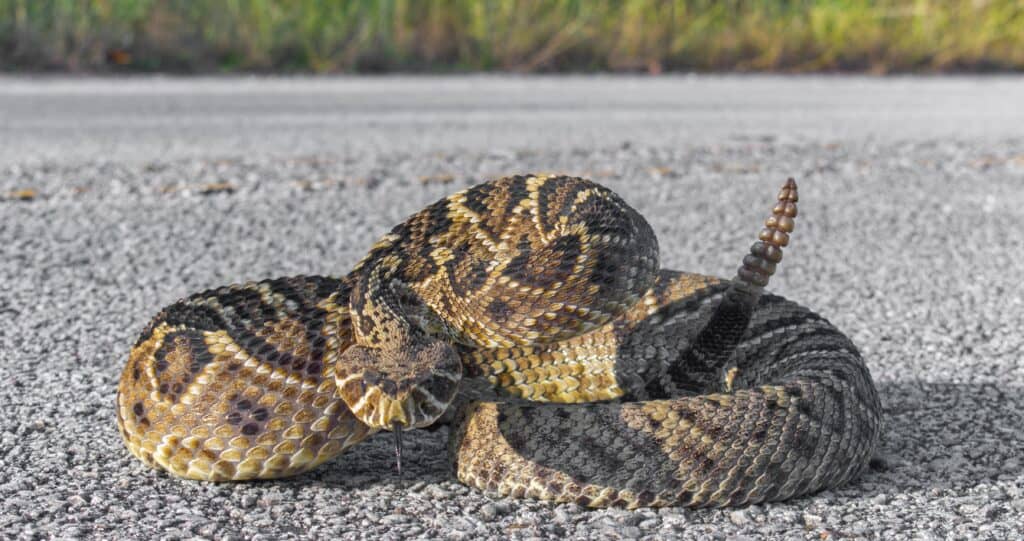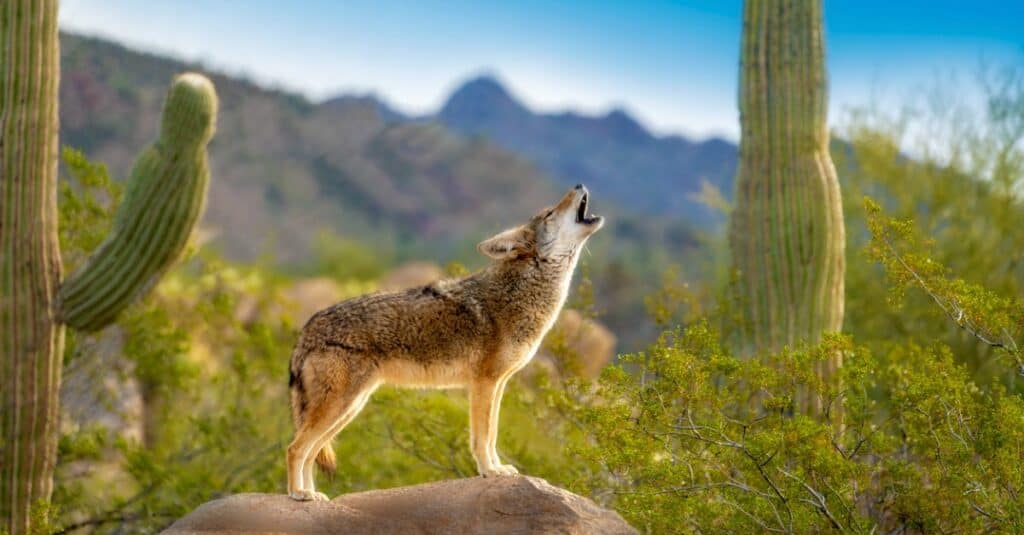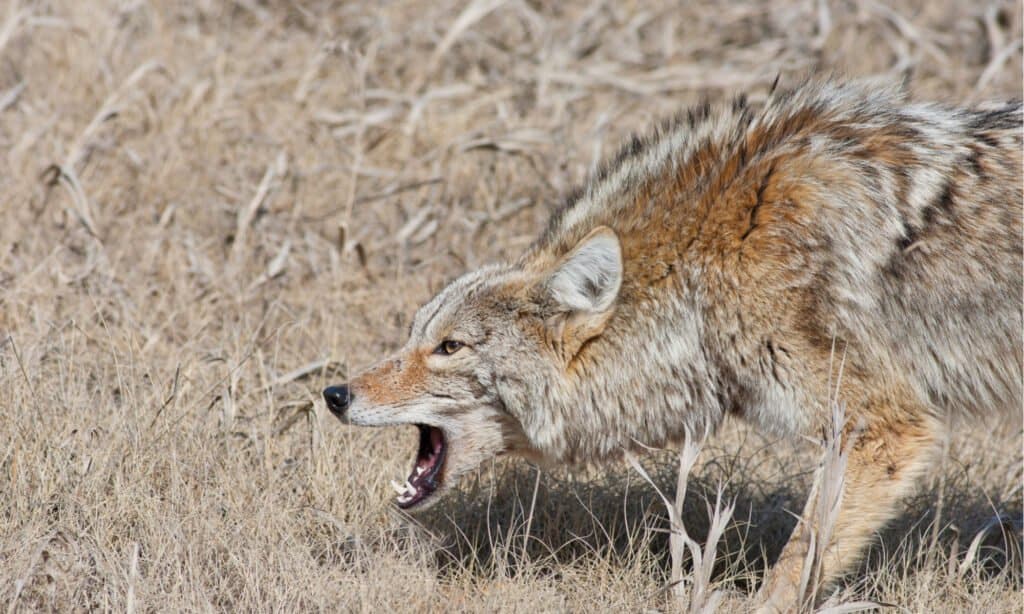The rattlesnake is equipped with highly potent venom that can easily take down a human being, while the coyote is one of the most agile and highly intelligent members of the Canidae family.
Thanks to how widely spread the two species are throughout the American continent, it is very likely that a coyote will come across a rattlesnake – or the other way around. Depending on the scenario, such an encounter can easily turn into a fight.
As a result, the question that must be answered is – who will win a rattlesnake vs. coyote battle? That’s what we’re here for; to help you understand who would win and, most importantly, why. Let’s look at these two cunning predators without any further ado.
What Is a Rattlesnake?

The rattlesnake is a venomous member of the
Viperidaefamily.
©Chase D’animulls/Shutterstock.com
The rattlesnake is a venomous member of the Viperidae family (subfamily Crotalinae). It is a predator spread throughout the Americas – Ontario, British Columbia, and even down to Argentina. It usually hunts small animals and rarely targets larger ones – unless provoked.
According to research, this snake is responsible for the great majority of snakebite injuries in North America, even though it doesn’t usually bite without provocation.
The largest species of the Crotalinae subfamily is the eastern diamondback – a rattlesnake that can grow up to 8 feet long.
What Hunts Rattlesnakes?
The main predators of the rattlesnake are king snakes, weasels, hawks, and coyotes. It is known that other species hunt this snake as well (such as fire ants). However, most do so when the rattlesnake is in its neonate (infant) phase and cannot defend itself.
What Is a Coyote?

The coyote is a member of the
Canidaefamily and
Canisgenus.
©JayPierstorff/Shutterstock.com
The coyote is a member of the Canidae family and Canis genus. It is widely spread throughout its native area, North America. Members of this species are known as versatile, easily adapting to the great majority of environments – even those altered by humans. It is a well-known fact that coyotes began to move into Canadian and US urban areas.
The coyote is a carnivorous animal. Its diet consists mainly of deer, hares, rodents, birds, and reptiles. However, as extremely opportunistic eaters, coyotes will often enjoy fruits and vegetables.
Coyotes thrive even in deserts where rattlesnakes populate. They do so to provide food for themselves and protect their young. The latter is considered one of the more unusual prey of a coyote, even though, reportedly, coyotes kill venomous snakes regularly.
The bite of a coyote generates a force of up to 88 PSI and is regarded as quite strong (a Pitbull, for example, has a stronger bite force). The animal’s intelligence and agility compensate for the lack of strength. The fact that coyotes are often found in small packs is also of great help.
What Hunts Coyotes?
The main predators of the coyote are cougars and gray wolves. Regarding threats to the species, humans are regarded as the main threat to the coyote. For the time being, only larger species are known to hunt or compete with the coyote.
Who Wins a Rattlesnake vs. Coyote Battle?

In a rattlesnake vs. coyote battle, a coyote will almost always win.
©Brenda Carson/Shutterstock.com
In a rattlesnake vs. coyote battle, a coyote will almost always win. This is because the coyote hunts for any source of food that is found in its current habitat. Even though the species prefers white-tailed deer, snakes will suffice if the territory doesn’t have anything else to offer.
In the book Rattlesnakes, Adele Richardson confirms that coyotes are rattlesnake predators and will actively hunt them if necessary. The harsh truth (for the rattlesnake) is that the coyote is too much of an opportunistic eater to pass on the opportunity to hunt a rattlesnake.
There are, however, a couple of factors that increase the chances of a rattlesnake being hunted by a coyote:
- The dry season is on – snakes are known to move very slowly during the dry season as temperatures go down. Naturally, as opportunistic eaters, coyotes will almost always prefer prey that moves slowly rather than quickly. This might also be one of the reasons why coyotes enjoy eating plants during fall and winter but switch to a mainly carnivorous diet during spring and summer;
- A rattlesnake is found near the coyote’s den – when a snake is found near its den that happens to be full of pups, the coyote will begin to make the necessary changes and ultimately move to a new location. Before doing so, however, coyotes may choose to actively hunt down the snake that stepped on their territory to eliminate any danger and threats to their pups;
- The coyote is hungry, and the rattlesnake is unlucky – last but not least, a rattlesnake might fall prey to a coyote simply because the latter is hungry and actively hunting.
How Does a Coyote Take Down a Rattlesnake?
The coyote’s hunting style changes in accordance with what it hunts. Larger prey, such as its favorite white-tailed deer, usually requires a group of coyotes to be taken down. They will surround the animal and chase it until a fatal blow is dealt.
For smaller prey, however, a single coyote is enough, mainly thanks to its cunning and extremely agile hunting method. First, the coyote uses its highly developed sense of hearing and smell to actively locate and then stalk snakes. When the time is right, the coyote will stiffen its legs, priming itself before pouncing on the snake and dealing a fatal blow with its jaws.
Depending on the scenario, the coyote might even throw the snake up in the air after locking its jaws onto it for safe measure.
Up Next:
- 11 Animals that Hunt Rattlesnakes
- Coyote Predators: What Eats Coyotes?
- Discover Every Type of Rattlesnake: The 45 Types of Rattlesnake
- Texas Showdown: Who Emerges Victorious in a Rattlesnake vs. Feral Hog Battle?
The photo featured at the top of this post is © FRAYN/Shutterstock.com
Sources
- Google Books, Available here: https://books.google.pt/books/about/Rattlesnakes.html?id=qJ2HpUI3CP4C&redir_esc=y
- Pest Pointers, Available here: https://pestpointers.com/yes-coyotes-eat-snakes-heres-how-and-why-they-do-it/
- Wikipedia, Available here: https://en.wikipedia.org/wiki/Rattlesnake#Predators
- Wikipedia, Available here: https://en.wikipedia.org/wiki/Coyote#Habitat
Thank you for reading! Have some feedback for us? Contact the AZ Animals editorial team.






